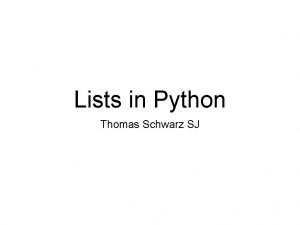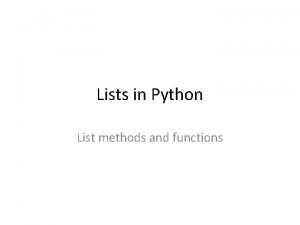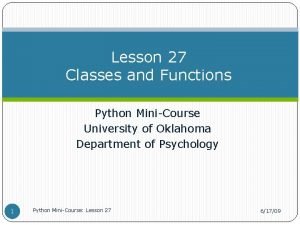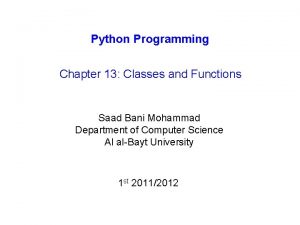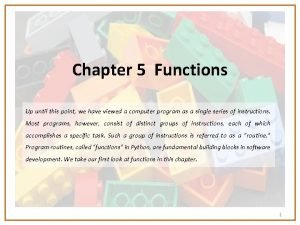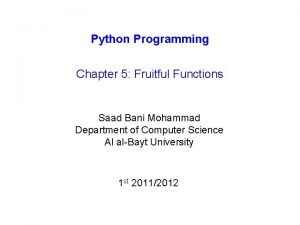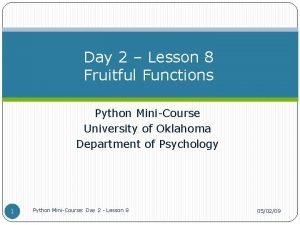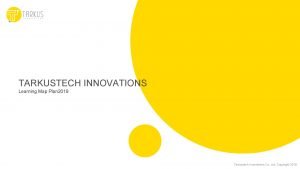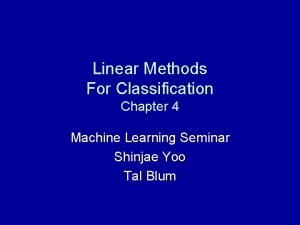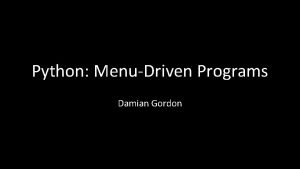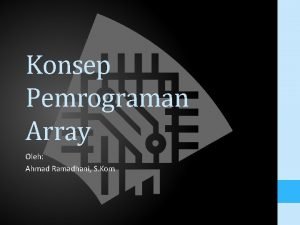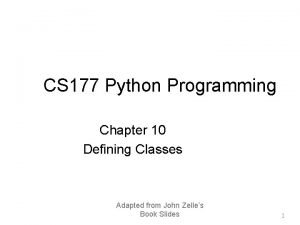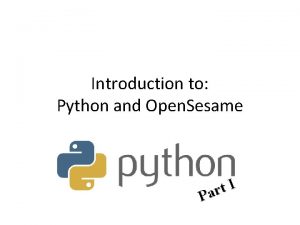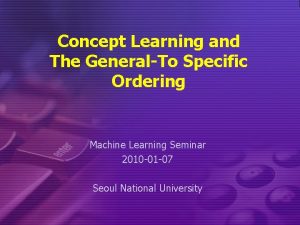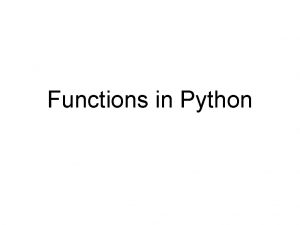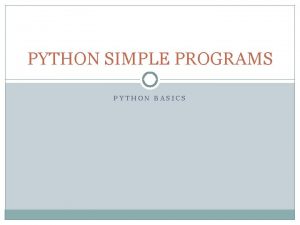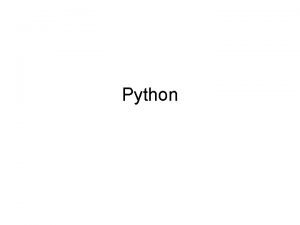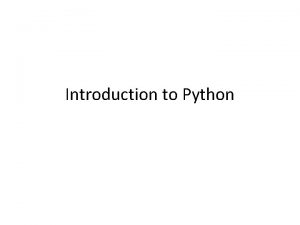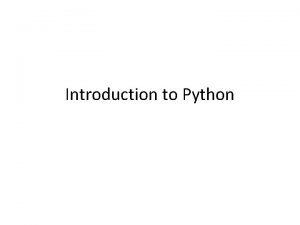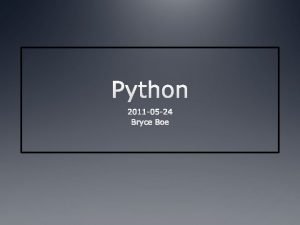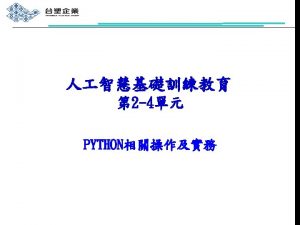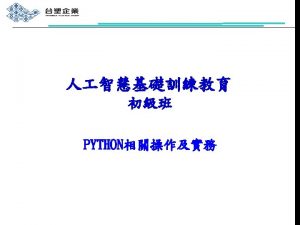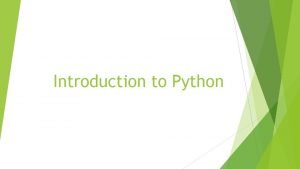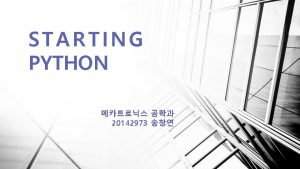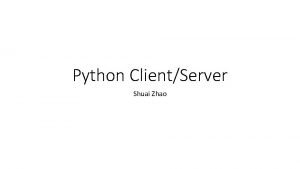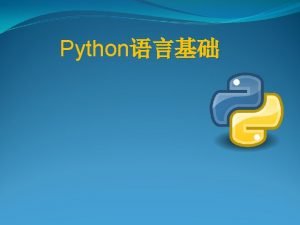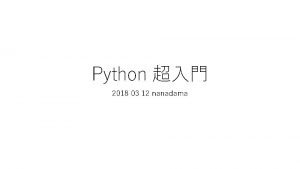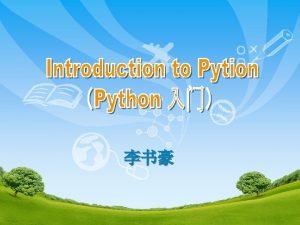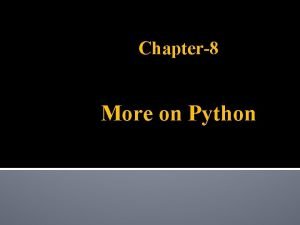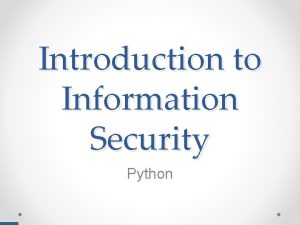Learning to Program in Python Concept 7 FUNCTIONS



















- Slides: 19

Learning to Program in Python Concept 7 FUNCTIONS (Definitions)

Learning Intentions From this lesson the students will be able to: 1. Create definitions 2. Pass parameters to definitions 3. Design solutions using their own definitions

Passing Variables to a Definition Predict what the definition above will do when called.

Passing Variables to a Definition • The function is passed a list and a new element for the list. (These are the inputs, or parameters, of the function. In this case mylist and mystring) • The new element is added on to the start of the list, and the list printed out. • The general syntax is : def function_name(parameters):

Call Me • Go to your IDE and try defining the function. • Pass a few more parameters to it to lengthen the list. • You can also append a new element to the end of the list. LO 1. 22 students should be able to read, write, test, and modify computer programs

Create Your Own Create a list containing the names of 2 famous people. For example : [“Lincoln” , “Yeats”] • Write a program, using definitions, that allows the user to add more elements to the list. • The definition should update the list and print it out each time it is updated. • The user wants to add between 1 and 10 people to the list. The user must be asked the number of new people they want to add. LO 2. 6 students should be able to construct algorithms using appropriate sequences, selections/conditionals, loops and operators to solve a range of problems, to fulfil a specific requirement

FUNCTIONS • We can pass in as many parameters to a function as we like: – def fancy. Number. Of. Inputs(a, b, c, x, y, z) • BUT we can only ever have one (if any) return from a function. • https: //docs. python. org/3/library/functions. html. . . Gives a list of Python built-in functions.

Return my Call The command return sends back the variable to wherever the function was called. (usually in the main program)

Return my Call Try it out. Change the function to perform a different task, such as double. Me.

ONE way or another Predict what this program will do when executed.

ONE way or another • We have a definition called calculate() which is called from inside the loop. • Calculate() takes in a number and divides that number by 100, returning the answer to the loop. • The function converts a percentage to its number equivalent e. g. 15% = 0. 15

Create your Own A Classic Example • Create a function to convert a number given in degrees Celsius to its Fahrenheit equivalent. • Call your definition cel. To. Fah(). • Its input is a temperature in degrees Celsius. • The formula for conversion is : Fah = (9 * Cel) / 5 + 32 • The UI should clearly state the input and the converted output.

Sample Code LO 2. 7 students should be able to implement algorithms using a programming language to solve a range of problems

CHALLENGE Write 3 programs, using definitions, that offer a User Interface to do the following conversions : 1. Convert miles to kilometres. 2. Convert kilometres to miles. 3. Converts in both directions! (Clue for definition 3 : One of the input parameters should tell your function which conversion to do. For example, if it is a Boolean variable, and called miles 2 kilometres, then if it is true the conversion is from miles to kilometres. If it is false, it is km to miles. )

The following task was completed during While loops. The Scratch challenge is to get the count. DOWN and count. UP numbers scrolling across the screen. What line of code is behind me?

A previous Challenge from the Dictionary Lessons Let’s say we have a string “dictionaries and lists” We need to count how many times each letter appears in the string. The information for each letter must be stored, easily accessed and also printed out. Using Think. Pair. Share, design an algorithm and pseudo code to solve this problem. LO 1. 7 students should be able to develop algorithms to implement chosen solutions

Sample code from Previous Letter Count Challenge

Enhancing the Letter Count Program Using the sample code or otherwise, write a program that: 1. Uses definitions to a) ask the user for a string b) clean the string of spaces and count the letters in the string c) print the analysis in a clear readable format. 2. If using the sample code, can you use less lines of code to perform the same task? 3. . LO 3. 5 students should be able to structure and transform raw data to prepare it for analysis

Learning Review From this lesson I am able to: 1. Create definitions 2. Pass parameters to definitions 3. Design solutions using my own definitions
 Concept learning task in machine learning
Concept learning task in machine learning Cuadro comparativo entre e-learning b-learning y m-learning
Cuadro comparativo entre e-learning b-learning y m-learning Python methods vs functions
Python methods vs functions Methods python list
Methods python list Pure function and modifiers in python
Pure function and modifiers in python Pure functions and modifiers in python
Pure functions and modifiers in python Up until this point
Up until this point What is fruitful function in python with example
What is fruitful function in python with example Def is_divisible(x, y): return (x % y) == 0
Def is_divisible(x, y): return (x % y) == 0 Esp32 map
Esp32 map Lda machine learning python
Lda machine learning python Stack queue python
Stack queue python Contoh program array 2 dimensi
Contoh program array 2 dimensi Python menu driven program
Python menu driven program Program gerobak fried chicken python
Program gerobak fried chicken python Python program
Python program Create python program
Create python program Who is your ideal self and your real self
Who is your ideal self and your real self Contoh marketing concept
Contoh marketing concept Find s algorithm machine learning
Find s algorithm machine learning


